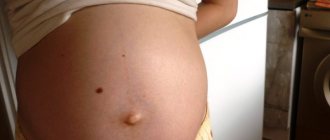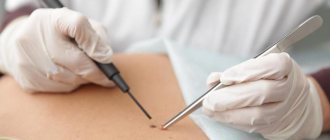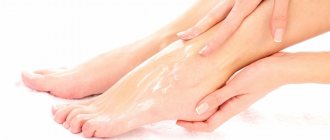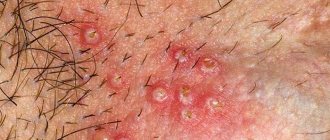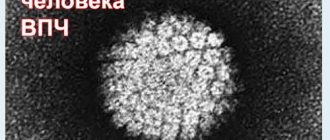During pregnancy, colossal changes occur in a woman’s body, and it is during this period that she is susceptible to various viral and infectious diseases that are associated with a decrease in the body’s protective functions.
One of the troubles that an expectant mother has to face is papillomas during pregnancy or human papillomavirus infection.
The papilloma virus, which appears on the skin in the form of formations, does not pose a danger to women and children.
Let's look at why papillomas appear during pregnancy, how they affect the body of the mother and fetus, and what methods of treating the disease exist.
Causes
Papillomas are caused by a virus that is present in the body of many people, but it is during pregnancy that it can begin to actively develop. It is impossible to answer unequivocally what is the reason for the massive growth of warts during pregnancy. Scientists put forward a number of assumptions:
- Hormonal surges . During the growth of the fetus in the womb of the mother, the female body undergoes hormonal changes. It is during this period that causeless tears, increased irritability and other manifestations of hormonal imbalance are possible. HPV (human papillomavirus) is in a hurry to take advantage of this opportunity and begins its activities.
- Increase in body weight . As the baby grows in the womb, the mother’s weight also increases; this phenomenon is considered completely normal. However, with significant weight gain, skin friction increases in various areas where folds form. This provokes excessive sweating and the spread of warts that have already appeared on the skin.
- The third factor that triggers the spread of the virus is weakened immunity . Often in the first trimester, a woman suffers from toxicosis, which impoverishes her diet and reduces the absorption of nutrients. At this point, exacerbation of chronic diseases is also possible.
Can papillomas disappear after childbirth?
Doctors have noted cases of spontaneous disappearance of formations from the surface of the dermis some time after childbirth. This phenomenon is associated with several reasons:
- Normalization of hormone levels in a woman’s body after the birth of a baby.
- Increasing the body's protective functions by observing sleep and rest patterns, physical activity, proper nutrition and taking vitamin complexes.
The disappearance of a growth on the skin after childbirth occurs infrequently; the virus, having entered the body once, tends to stay there forever; it is not always possible to eliminate it completely. But it can be transferred to an inactive position with the help of treatment with antiviral medications and maintaining a healthy lifestyle. Most types of the virus provoke the growth of benign formations, which are easily removed using modern techniques.
In pregnant women, skin formations (papillomas, condylomas, age spots) appear due to hormonal changes and decreased immunity, and after childbirth they disappear without treatment.
The article has been reviewed by the site editors
Locations
The degree of danger of papilloma during pregnancy is often determined by the type of virus strain that caused their appearance. The location of the growths is important. Different types of viruses choose their favorite places : on the neck, chest or genital area, and some types of virus can form on a woman’s internal organs. If the presence of the former can be determined visually, then formations on the cervix, for example, are usually detected during an examination by a gynecologist.
On the neck
The neck is a place where warts appear quite often. It is there that they are noticeable not only to the woman, but also to others.
Typically, growths on the neck look extremely unattractive, but do not pose any danger. However, when injured by a hair brush, such formations can cause anxiety , and large ones can transform into malignant ones .
On the cervix
HPV often manifests itself as the appearance of tumors on the genitals, as well as on the cervix in women. If there are a lot of warts, they can cause discomfort, especially if the disease is in an advanced stage.
Infection with the cervical virus sometimes does not appear at all or has the following symptoms :
- uncharacteristic vaginal discharge
- burning of the genitals;
- enlarged lymph nodes.
This condition is undesirable during the period when a woman is expecting a baby. Therefore, it is recommended to clean the affected areas in advance, before pregnancy .
If the problem was discovered only during pregnancy, there is a possibility that self-healing will occur after childbirth . However, with extensive lesions of the mucous membrane and large growths, problems may arise during delivery. In rare cases, such a diagnosis serves as a reason for making a decision about a caesarean section.
On the chest, nipples
These formations occur quite often in pregnant women on the breasts and nipples. Moreover, after childbirth they usually disappear on their own.
The danger of such localization is that it increases the risk of infection of the child during feeding. Pregnant women are advised to carefully monitor hygiene so that the infection does not spread to other parts of the body.
Photo 1. During pregnancy, the female body becomes more vulnerable, including to the effects of viruses. Source: Flickr (Dr Ruby Sehra)
Does it affect the course of pregnancy?
There is no clear answer to this question, because, firstly, the immunity and health status of different women differs: in some, papilloma disappears on its own after childbirth, in others, the virus combines with an infection and can lead to unpleasant consequences.
Secondly, there are diametrically opposed opinions of doctors regarding the harm of papillomavirus during pregnancy. Some believe that HPV activity can lead to miscarriage.
The greatest danger is caused by papillomas in the intimate area (vagina, cervix, labia), since they cause discomfort to a woman when walking and can be a “magnet” for various infections.
It is also unsafe if the papilloma is accidentally (or deliberately) damaged, since a violation of the integrity of the skin, combined with a weakened immune system, represents a “gate” for other pathogens to enter the body (viruses, fungi, bacteria).
The psychological aspect is no less important: the woman will be nervous, worried, worried about possible harm to her and the child, and stressful situations during pregnancy are unacceptable.
In general, the danger of papilloma during pregnancy is often increased, and the disease goes away after childbirth completely without a trace.
What is the danger
As mentioned above, most often such growths do not pose a danger, but there are exceptions. Let's look at how HPV can affect mother and child.
Impact on the child
The main danger of the disease is that the mother can infect the baby . However, this is only possible during childbirth or after. If neoplasms are found on the genitals and cervix, the baby may become infected as it passes through the birth canal .
If warts occur on other parts of the body - on the chest, nipples, the mother can become a source of infection while feeding the child.
For woman
Since there are quite a few strains of the virus, you should find out which one the woman is infected with . Some types are oncogenic and can develop into a malignant tumor. Scientists have determined that the most dangerous are strains 16, 18, 39 and some others. That is, if this type of virus is detected, it is best to undergo appropriate treatment.
Factors provoking HPV
Since the immune system is weakened, any external influence on the body can be detrimental to health and provoke the proliferation of epithelial tissue.
First of all, it is influenced by promiscuous sex life. HPV is transmitted primarily through sexual contact, so if the expectant mother does not have one regular partner, the risk of developing the disease increases.
Bad habits such as smoking, drinking alcohol and taking drugs are another significant risk factor.
REFERENCE! The condition of the skin before pregnancy does not affect the likelihood of papilloma.
Proper nutrition is of great importance, because with an excess or deficiency of certain substances, all organs and systems suffer, which affects the condition of the skin, the weight of the expectant mother, and vascular health.
The presence of other viruses in the body (for example, HIV) increases the risk of developing papilloma, as well as the presence of various endocrine diseases (diabetes mellitus).
Routes of infection with HPV
HPV infection occurs in several ways.
- during sexual intercourse ;
- from person to person when shaking hands or other bodily contact ;
- through the use of general hygiene items ;
- from mother to child during childbirth .
Note! Infection of an infant during delivery is extremely rare. It is estimated that this only happens in 0.01% of cases.
Methods for removing tumors during pregnancy
The decision to remove papillomas during pregnancy is made by the doctor, taking into account all the risks and determining the nature of the tumors. The doctor will examine their location, appearance and recommend further treatment. As a rule, if the growths do not interfere, do not grow or are not injured by clothing, the doctor recommends not removing them before childbirth. However, in some cases, deletion may be the only correct solution:
- if the growths are actively growing;
- are in an inconvenient place and are exposed to injury;
- cause discomfort - itching, burning.
All existing methods of eliminating the manifestations of the virus can be used during pregnancy. The only contraindication is the use of anesthesia. However, the doctor may use a drug that will not harm the fetus. Apply:
- cryodestruction;
- electrocoagulation;
- laser removal ;
- removal with a scalpel.
Laser removal is considered the most gentle, but this method is applicable only for small formations. Larger units are often removed with a scalpel using anesthesia.
Photo 2. To decide on the removal of papillomas during pregnancy, the gynecologist must determine the type of virus strain. Source: Flickr (IVFworld).
Removing papilloma during pregnancy yourself
Not all expectant mothers rush to the dermatologist when warts are detected. Many believe that using folk methods when a girl is in an “interesting position” is most preferable. This is not entirely true, because by cauterizing the neoplasm, you can cause infiltration of adjacent tissues, and even purulent inflammation .
It is important! Pregnancy is a condition when under no circumstances should you risk your health and the health of your unborn child. If removal is unsuccessful, papillomas begin to multiply with a vengeance, and some of their types can even degenerate into malignant formations.
Features of treatment
Treatment of papillomas during pregnancy is a very delicate issue. Many women decide to have papillomas removed during pregnancy only because they develop their own complexes.
No one argues that the formation of warts negatively affects a woman’s appearance. This is especially true when papillomas affect open parts of the body. The most unpleasant scenario for the development of events is a growth that appears on the face.
But if papillomas appear during pregnancy, do not rush to run to the clinic to have them removed. In certain situations, dealing with deletion issues is acceptable. But to the question whether pregnant women can remove papillomas on their own at home, the answer is obvious - absolutely not.
Warts can appear in the most unexpected and unpleasant places. We have already determined exactly why they are formed - this is a combination of the fact of the presence of the virus in the body and the impact of negative factors on the immune system.
It is not recommended to treat or remove growths if papillomas appeared during pregnancy in the following situations:
- The growths do not cause discomfort to a pregnant woman;
- New growths do not constantly come into contact with clothing;
- Do not become inflamed;
- Do not change shape, size or color.
However, there are situations, shown in the photo, when neoplasms cause severe discomfort, constantly rub against clothing or are injured. In this case, removal is the optimal solution to the problem. Moreover, for removal it is recommended to use:
- Freezing with liquid nitrogen;
- Laser coagulation;
- Radio wave excision.
As for direct treatment with medications, tablets or ointments, they are prescribed extremely rarely. Most medications aimed at combating the virus have contraindications for pregnant or nursing mothers. Therefore, they cannot be used in treatment.
Preventive measures
They are relevant for those who are just planning a pregnancy. To reduce all risks to zero, and also to reassure yourself when carrying a child, you need to first think about the issue of protection against the papilloma virus.
The appearance of growths is relevant only for those women who were carriers even before pregnancy. You can catch the virus even during pregnancy through sexual or household contact. Let's give some recommendations in this regard.
- Sexual partner. If you are planning a pregnancy, you should only have one partner, just like him. This will protect you from possible virus infection.
- Domestic issues. If there are no carriers of the virus in the family, there should not be any special problems in everyday life. The presence of a carrier, even if there are no external manifestations of HPV in the form of growths, requires vigilance when using hygiene products, care products, etc. Try to use only your personal belongings and not share them with the carrier.
- Analyzes. Before pregnancy, be sure to take an HPV test with your partner to exclude its likelihood during pregnancy or to treat papillomas in a timely manner.
- Immunity. It's no secret that the immune system is greatly weakened during pregnancy. But there are many ways to keep it as high as possible. This is proper nutrition, physical activity or hardening of the body. In this regard, consult with specialists so that the fight for immunity does not begin during the baby’s life.
Papillomas are far from the worst thing you can encounter during pregnancy. But under no circumstances should they be ignored.
Treatment of HPV during pregnancy
Medicines
HPV should be treated comprehensively. Dermatologists usually recommend treating the virus in three ways at once:
- immunity stimulation;
- taking antiviral drugs;
- removal of formations in order to stop their spread.
During pregnancy, treatment should be gentle. All antiviral agents should not be used by expectant mothers, especially in the first trimester. Also, do not abuse immunostimulating drugs. The best way of therapy is to strengthen the immune system and maintain careful hygiene . It is better to start full treatment after childbirth.
Treatment with folk remedies
Among the current folk recipes are the following:
- Cauterization with garlic . You need to take a clove of garlic and grind it into a paste.
- Using vinegar essence with flour . Add a few drops of vinegar essence to the flour and roll into balls.
- Celandine juice.
When cauterizing skin formations, care should be taken to ensure that the active substance does not come into contact with healthy tissue . To ensure safe manipulations, it is recommended to use a patch. Cut a hole in a small piece of adhesive tape and stick it on the skin so that the growth is on the outside and the surrounding tissue is protected.
Then apply garlic paste to the new growth or stick a dough based on vinegar essence. Secure the product on top with another piece of plaster.
These stickers can be made for an hour, two or all night.
Repeat for several days. If celandine juice is used, such precautions are not required. It is enough to lubricate the affected area with a broken stem of the plant, and repeat the procedure again after 1-2 days. The wart will gradually dry out and fall off.
Photo 3. A pregnant woman’s diet should be rich in vitamins. Source: Flickr (Josh Janssen)
Preventive measures
It will not be possible to avoid the appearance of papillomas during pregnancy if the infection has already occurred. The only method of prevention available to pregnant women is strengthening the immune system and careful hygiene .
- You should avoid contact with strangers - handshakes, kisses, hugs.
- Do not use other people's towels , do not take clothes from friends.
Also try to monitor your weight and not gain extra pounds. In this case, the diet should be complete.
You should not neglect taking vitamins .
If, however, neoplasms appear on the body, it is better to immediately visit a dermatologist . The doctor will help you choose adequate therapy and prevent the infection from spreading to other parts of the body.
Papilloma on the nipple and breast
What are the features of papilloma on the nipples during pregnancy? When do papillomas appear on the chest? The appearance of a wart on the chest can only cause inconvenience to a woman, or she will feel complex about the unaesthetic appearance of her body. Papilloma may appear on the halo and threaten to stop the baby from feeding. After all, this will appear:
- quite severe pain;
- there will be a release of fluid along with the milk;
- At the site of the papilloma, a crack first forms, which can later turn into an ulcer.
What can affect nipple papillomas during pregnancy? The nipple will be very sensitive and if the child sucks on it, fluid from the wart will enter the body. In this case, the woman will develop a poorly healing wound. Papilloma on the entire halo can also cause pain.
To prevent various complications, pregnant women and all women are recommended to:
- Carry out independent examinations of your breasts and nipples approximately once a month.
- When monitoring during pregnancy, do not neglect the advice of a gynecologist or other specialist.
- Never self-medicate.
- Support immunity.
- Visit your doctor regularly.



